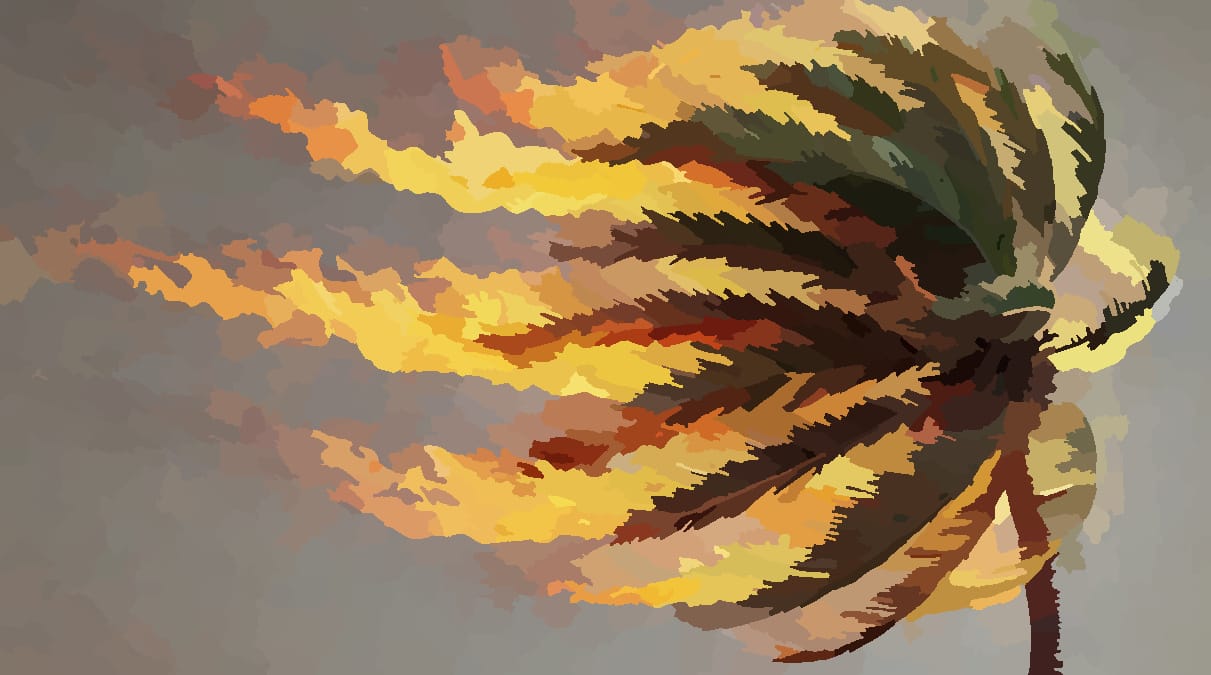
Santa Ana and the fires to come
The seasonal high winds that once seemed a romantic part of living in Los Angeles now stir an annual sense of doom.
In 2021, when I was working with low-income patients in Butte county after the devastating Camp Fire, I wrote about the lack of access there to quality healthcare and the pervasive sense of hopelessness which together often led to premature death. But in my piece, I also wrote about the transformation I’d witnessed over the years of the Santa Ana season of my youth: “Growing up in Southern California in the 1970s and 80s, fires were an issue in the summer or the early fall, but they generally petered out before school began. With some well-known exceptions, they usually burned far from more populated areas. In fire season, the so-called Santa Ana or Diablo winds picked up and the hot air blew palm fronds onto our driveways and dispersed the smell of jasmine. As a child, these gusts transported me to exotic places. They almost felt romantic.”
In January 2025, I find myself haunted by my own words, even by my own feelings.
I’m from Santa Monica Canyon, a mosaic of post-and-beam homes nestled amongst eucalyptus and avocado trees, dotted with secret stairways, and a rec center that once served as a speakeasy for Old Hollywood in the 1920s. Our canyon connects to Pacific Palisades via Sunset and Chautauqua Boulevards and Pacific Coast Highway. The Palisades was our town, where we went to high school, shopped for food, saw our doctors, and followed friends home after a day at Will Rogers State Beach.
You may know those street names by now. The fires that recently shook and massacred Southern California rival the once unthinkable Camp Fire and so many others disasters from that time. This includes the devastating Montecito mudslides that took place during another January, seven years ago. Those were the result of the Thomas Fire that ravaged and desiccated the mountains, priming them to fall down and destroy homes and lives.
Exotic and romantic. This was my description of the winds of my childhood. At the time they stood out, marking a notable change from our preternaturally still and dry 73-degree weather. I remember the stirring. As the palm trees started swaying I might have been lying at the beach on the warm sand, the salt air mingling with Hawaiian Tropic sunscreen and my friend Chantel’s sweet perfume called Dreams. Then, the weather felt dreamy. Now, it causes trauma.
A few days ago, we were told the Santa Ana winds would imminently return in full force. Boxes of documents, photo albums, diaries, and clothing are packed by the door. My nose perks up at any whiff of smoke, even my husband’s tortilla on the stove. The waving trees outside my windows now bring with them a deep dread. I want to tear them all down.
On January 7th, embers traveled two miles from their source, igniting whole communities. In their wake, much of my hometown, and Altadena where my mother once lived as a little girl, transformed into charred flatlands.
“Within hours, the town of Paradise, California was consumed… And as authors Alastair Gee and Dani Anguiano described so vividly in Fire in Paradise: An American Tragedy, the winds ‘disperse wildfire embers as easily as a child flinging dandelion seeds into the breeze.’ This is what happened in Paradise.”
At the time that I wrote of the fire in Paradise, I had no idea how prescient Gee and Anguiano’s quote, mingling childhood and catastrophe, would be for so many of us. What the authors also understood, and what paleoclimatologists like Amy Hessl recognize, is that due to the Santa Ana winds, there is no end in sight for the fire danger in California. “Air will move from high to low pressure and, in the case of the Santa Anas, this means that really hot, dry air moves from the desert up over a series of mountains," Hessl explained after the recent fires. "Every time that air descends towards the coast, it gets hotter due to an increase in pressure…Many fire scientists and firefighters believe that the Santa Anas produce the most extreme fire conditions anywhere in the world.”
Hessl added that the increase in fire events results from human contributions to climate change, the way land is managed creating fuel for fire, and migration patterns that put people “in the way of fire.”
So what lies ahead for these fire impacted areas? Some believe we need to change the way we prepare for fires. Suggestions from Alice Hill who once worked in the White House focusing on resilience policy include the following: “expanding evacuation routes, creating larger fire breaks around communities, conducting more controlled burns, enhancing firefighting and emergency management training, improving vegetation management, and enhancing early warning systems.” Additionally, she implores communities that are rebuilding to consider factors like housing density, vegetation, and enhanced emergency preparedness plans.
What’s also important to consider as we move forward with this new understanding of what lies ahead is the emotional toll. It’s been nourishing to witness the outpouring of love and support, both emotional and material, for those who lost loved ones and homes. We also need to ensure that mental health resources and avenues for compassionate connection to others are available in an ongoing way. This at a time when people are experiencing loss and instability, facts of life which are expected to remain imminent dangers for the duration.
